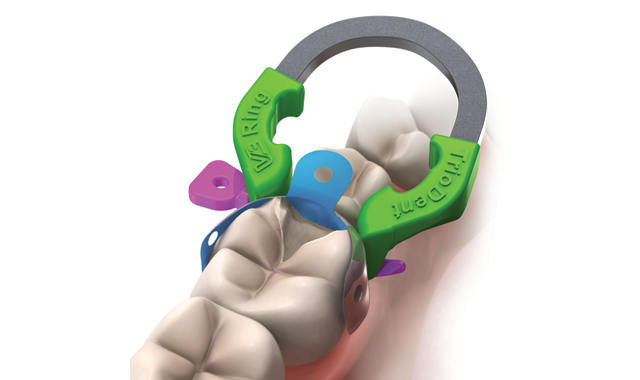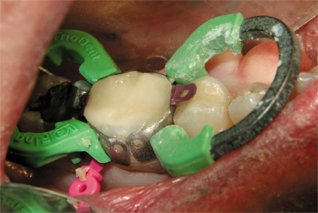How the Triodent V3 Ring solves restorative issues
How this sectional matrix system can be used to ensure excellent contacts and contour of every restoration.

Contacts and contour: Two very important parts of every direct restoration placed by dentists around the world. When placing any direct restorative material in a dental preparation that involves a proximal box, the dilemma is often how do you get optimal contacts and contour in the final restoration? The matrix used and how it is placed is critical for the overall success of the restoration.
There are a multitude of matrix bands and retainers in the dental marketplace, including circumferential, tofflemire-type retainers and sectional matrix bands. Each has its place and effective use in the dental practice, and having each of these types available is valuable in the day-to-day workings of the office.
Trending article: 9 ways EHRs save time and money
One of the sectional retainers we use at my office is the V3 Ring by Triodent®, distributed by Ultradent Products Inc. This “go-to” system features unique “V”-shaped tines that help to ensure that the retainer places equal gripping pressure on the wedge and the embrasures of the adjacent teeth and provides optimal separation force to help produce consistently tight contacts. These V3 Rings have wonderfully high strength and stability, with reliable long-term use being a highlight of these products. They can essentially “take a licking” - they work consistently well even after multiple uses over a long time period and repeated autoclaving of the rings.

The design and elasticity of the NiTi ring structure provides optimal spring strength, and the glass fiber reinforced plastic tines with their “V” shape enable great adaptation around wedges. These rings are “stackable” and come in two types: the universal (green) V3 Rings for large teeth and the narrow (yellow) rings for small teeth. And of course, the V3 rings are autoclavable. They also are available in a blue plastic disposable type, which are designed for single use. They provide the same wonderful results as their sister V3 rings, but they are disposable.
The V3 Sectional Tab-Matrices have a pronounced ridge at the occlusal margin of the matrix, helping to produce a very natural-looking Class II composite restoration, which aides in the quick and easy finishing of that area of the restoration. Also, the contour of the matrix helps to develop the final contour of the restoration very nicely. They are super thin (30 μm) yet very strong. Also, the tab at the occlusal of the matrix makes placement of the V3 Sectional
Matrix band easy to place with the Triodent Pin-Tweezers. The size of the matrices ranges from 3.5 mm to 7.5 mm, and they come in SuperCurve and ClearMetal types, too.
The SuperCurve Matrices are color-coded, so size differentiation is easy, and they have a nonstick coating to make the removal of the matrix easier. The extra curve dimension also helps with those wider buccal-lingual extensions that we run across when preparing for some Class II restorations and, once again, assures the operator wonderful contacts and excellent contour of the final restoration.
The ClearMetal matrices are wonderfully unique matrix bands. They are the only transparent metal matrix bands. They have hundreds of clear resin-filled micro-windows that allow light to pass though the matrix while curing, yet they are strong and function just like the Tab matrix or the SuperCurve matrix with the V3 Ring System. Because of the clear resin-filled coating in the micro windows, they are nonstick for easy removal and enable a super smooth interproximal surface. You can really be sure you have a fully cured composite with these matrices, since light can easily pass through the windows of the ClearMetal with great contacts and fabulous contour.
More from the author: How to get protection under all composite restorations
Probably my favorite feature of the Triodent™ V3 Ring system is the WedgeGuard preparation wedges. These WedgeGuards help prevent nicks and damage from your rotary instruments on the adjacent teeth during preparation. Once you are finished with the preparation, simply pull off the metal guard and slide the V3 matrix band of your choice next to the remaining Wave-Wedge-like wedge of the WedgeGuard, apply the appropriate V3 Ring and restore. It’s that simple. The Wave-Wedge has a great anatomic design that keeps the matrix easily in place, seals the gingival margin of the restoration and protects the interproximal papilla. Its triangular-like profile works splendidly with the V3 Ring, enabling an interlocking of the wedge and the V3 ring.
Having the V3 Ring in our armamentarium at the office has helped me solve many interesting and complicated restorative issues, since it is very versatile and makes posterior Class II restoration work so much more predictable and reliable.